Yamaha Introduces Tunable Ski and Slippery Hyfax
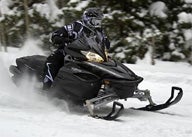
We'll all benefit from the work of Yamaha engineers
Recently we trekked down to Yamaha’s Midwest Headquarters in Wisconsin for a briefing on some new technologies that you’ll be able to add to select Yamaha snowmobiles for the upcoming season. We’ll take a stab at guessing that these optional features may become standard in future models.
Actually, a couple of the features might have been incorporated into new model sleds but for the recent natural disasters that befell that island nation this past March. Fortunately, Yamaha itself was left fairly unscathed, but suppliers were not all so lucky and it affected Yamaha to varying degrees.
Virtually all snowmobile shipments to the U.S.-based Yamaha division will be on a similar schedule as last season. Ironically, the U.S. group originally moved its delivery up a month, but with the “troubles” in Japan, everything reverted to last season’s schedule, meaning that from a dealer and consumer standpoint, Yamaha in the U.S. is right “on schedule”!
Ski Tuning
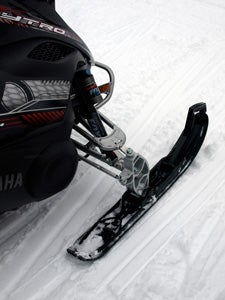 The current 2012 stock Nytro ski is designed for aggressive riding, but can’t offer the handling options available with the new optional “Tuner” ski.
The current 2012 stock Nytro ski is designed for aggressive riding, but can’t offer the handling options available with the new optional “Tuner” ski.When we test rode the 2012 Yamaha models in Yellowstone this past spring, it was hinted that there might be a “new” ski coming for us to test out. As it turns out, it’s not just a ski, but also a “ski system” that will be available to consumers this fall. But, Yamaha being Yamaha didn’t just design a singular ski. No, Yamaha created what has to be the industry’s first tunable ski.
Yamaha long has been working to create a ski that would work with its rider-forward type sleds. The ski needed to be aggressive for good bite in the corners, but not too aggressive to cause serious “darting” issues on the trail. As you may have noticed with the newer skis developed for the electric power steering (EPS) equipped Apex and Vector models, the skis on those sleds have reworked keels that are at once flatter and wider to cut down on darting.
But, when Yamaha engineers probed ski designs, they ran into all kinds of patents for existing and yet-to-be introduced designs. As Yamaha discovered, designing a ski requires more than engineering, it required avoiding patent infringement as well, which sometimes took engineering in different directions.
The overall goals for a new ski centered on making the new design predicable, which meant that it had to be an anti-darting design with light overall steering effort but with strong attributes for positive handling and overall control. Seems easy enough?
As you may have noticed, Yamaha has tried a number of ski designs. The single keel, single runner designs couldn’t eliminate darting. Even adding two runners to a single keel design ski wasn’t the answer as it added to overall cost and effectively left the rider with too much “push” in the corners. That’s when engineering started taking a hard look at a dual keel design that incorporated dual runners.
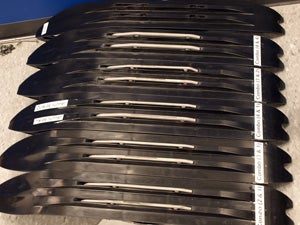 Yamaha’s “tunable” ski concept consists of a dual ski with two interchangeable runners that give you an impressive range of options for handling and straight-line stability.
Yamaha’s “tunable” ski concept consists of a dual ski with two interchangeable runners that give you an impressive range of options for handling and straight-line stability.Taking this direction has led to an all new ski concept that Yamaha calls the “Tuner Ski.” It features a dual keel design and is angled just a bit to keep snow and debris from piling up between the dual runners. Made from a compression molding process, the ski is light in weight and presents a nice gloss finish on the snow. In reality the ski weighs in one-pound less than the current ski design.
The real beauty of this ski lies in its total functionality that allows the rider to literally mix and match runners to get a “just right” blend of performance for aggressive trail riding, cross-over riding, high mileage riding or whatever. Another benefit of the new ski is that it will fit virtually any 2003 or newer Yamaha Apex, Nytro, Vector, Venture or Phazer.
The host ski will accept any of four currently available runners, including: a 9mm runner without carbide; 9mm runner with 2-inches of carbide; 11mm runner with 4-inches of carbide; or the extremely aggressive square 11mm runner with a full complement of 6-inches of carbide. At present Yamaha has prepared a chart to offer suggested partnering of runners to ski combinations for simply achieving anti-darting to full on high-performance handling characteristics. This enables you to blend the inner to outer ski runners to achieve steering and handling characteristics best suited to your riding style. Use a non-carbide runner with a small amount of carbide or go full-on with 6-inch carbides.
Yamaha claims that its “tunable” ski can be set to increase straight-line stability, minimize on-trail darting or impart light steering effort. According to Yamaha the benefits of the new ski tuning can be felt immediately. We tend to believe Yamaha on that one.
We give Yamaha an A-plus in innovation on this design, as it should be well received by snowmobilers looking to fine-tune their sled’s handling. This looks like it may well be one of those once in a while breakthroughs that will set the future tone for on-trail ride-ability. Kudos to Yamaha.
Slippery Slide
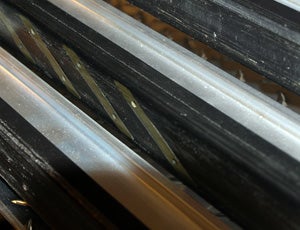 Using angled pieces of DuPont Vespel in the hyfax, center, makes the slide more slippery for longer life and less friction versus standard hyfax.
Using angled pieces of DuPont Vespel in the hyfax, center, makes the slide more slippery for longer life and less friction versus standard hyfax.Another new product introduction coming from Yamaha, and arguably beneficial more to Yamaha owners than other sled owners, is an all-new DuPont slide rail piece that utilizes a proprietary Vespel material. Essentially Vespel is a lightweight, very slippery, extremely strong polymer product developed and used since 1963 in aerospace applications. More recently a Vespel product has been included for use as thrust washers in a new 7-speed automatic transmission for a rear-drive vehicle. In this instance the Vespel replaces all-metal bearings.
Yamaha is using DuPont’s Vespel material in its “hyfax” runners because the product offers superior resistance to heat and wear. Any Yamaha owner knows all too well the sled’s tendency for the track to adhere to the hyfax when run in marginal snow or severe conditions. This should help alleviate that little idiosyncratic tendency.
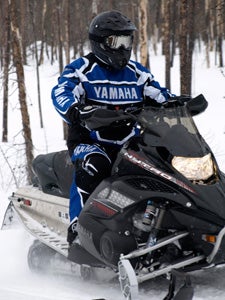 With Yamaha’s newest ski and slide hyfax, you can get better handling, improved wear and, perhaps, improved fuel efficiency and top speed.
With Yamaha’s newest ski and slide hyfax, you can get better handling, improved wear and, perhaps, improved fuel efficiency and top speed.In addition to extended slide life, Yamaha suggests that the new Vespel slides can lower track/slide friction, which should mean some kind of an improvement in top speed as well as better fuel efficiency since the rails won’t have as much inherent drag.
While Yamaha has tested the product extensively, the overall benefit for Yamaha owners will be less frequent change of hyfax. Of course, the length of the product’s life cycle depends totally on how the rider uses his sled.
You can expect this new hyfax system to be available at dealerships this season. It retains the same dimensions of the original slide and will be available to fit existing 121-inch through 144-inch slide rails. Check with your dealer for availability and pricing.
Obviously we can’t foretell the fortune, but we have to believe that these two new technologies will be copied and used by Yamaha’s competition. After all, these are two good ideas that carry with them the generic usefulness of other concepts such as electronic reverse and hand warmers that have been adopted by all snowmobile manufacturers. These good ideas offer benefits to all snowmobilers. Any snowmobiler who has changed hyfax once or twice in a season will appreciate these slippery slides with their extended life cycle. And the new ski design simply brings a degree of tunability never seen before. Watch for these technologies to be commonplace within five years.
Related Reading Inside Yamaha’s Mono Shock II Air Suspension Inside Yamaha’s EXUP Exhaust Do-it-Yourself Ideas for Your Yamaha Get Your Yamaha Ready This Summer





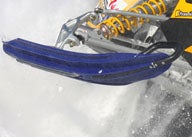


 Your Privacy Choices
Your Privacy Choices